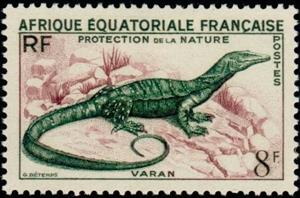Stamp: Monitor Lizard (Varanus sp.) (French Colonies 1955)
Monitor Lizard (Varanus sp.) (French Colonies 1955)
01 January (French Colonies ) within release Equatorial Africa goes into circulation Stamp Monitor Lizard (Varanus sp.) face value 8 Central African CFA franc
| Stamp Monitor Lizard (Varanus sp.) in catalogues | |
|---|---|
| Yvert et Tellier: | Yt:FR-EQ 231 |
| Michel: | Mi:FR-EQ 296 |
Stamp is square format.
NatureAlso in the issue Equatorial Africa:
- Stamp - Monitor Lizard (Varanus sp.) face value 8;
- Stamp - Flottage du bois-Timber floating face value 50;
- Stamp - Pêcheur Kotoko-fisherman Kotoko face value 100;
- Stamp - Mécanisation-mechanization face value 200;
- Stamp - Gouverneur général Eboué face value 15;
|
Data entry completed
50%
|
|
|---|---|
| Stamp Monitor Lizard (Varanus sp.) in digits | |
| Country: | French Colonies |
| Date: | 1955-01-01 |
| Perforation: | 13 |
| Format: | Stamp |
| Face Value: | 8 Central African CFA franc |
Stamp Monitor Lizard (Varanus sp.) it reflects the thematic directions:
Reptiles are tetrapod (four-limbed vertebrate) animals in the class Reptilia, comprising today's turtles, crocodilians, snakes, amphisbaenians, lizards, tuatara, and their extinct relatives. The study of these traditional reptile orders, historically combined with that of modern amphibians, is called herpetology. Because some reptiles are more closely related to birds than they are to other reptiles (e.g., crocodiles are more closely related to birds than they are to lizards), the traditional groups of "reptiles" listed above do not together constitute a monophyletic grouping (or clade). For this reason, many modern scientists prefer to consider the birds part of Reptilia as well, thereby making Reptilia a monophyletic class.
Animals are multicellular, eukaryotic organisms of the kingdom Animalia (also called Metazoa). All animals are motile, meaning they can move spontaneously and independently, at some point in their lives. Their body plan eventually becomes fixed as they develop, although some undergo a process of metamorphosis later on in their lives. All animals are heterotrophs: they must ingest other organisms or their products for sustenance.


